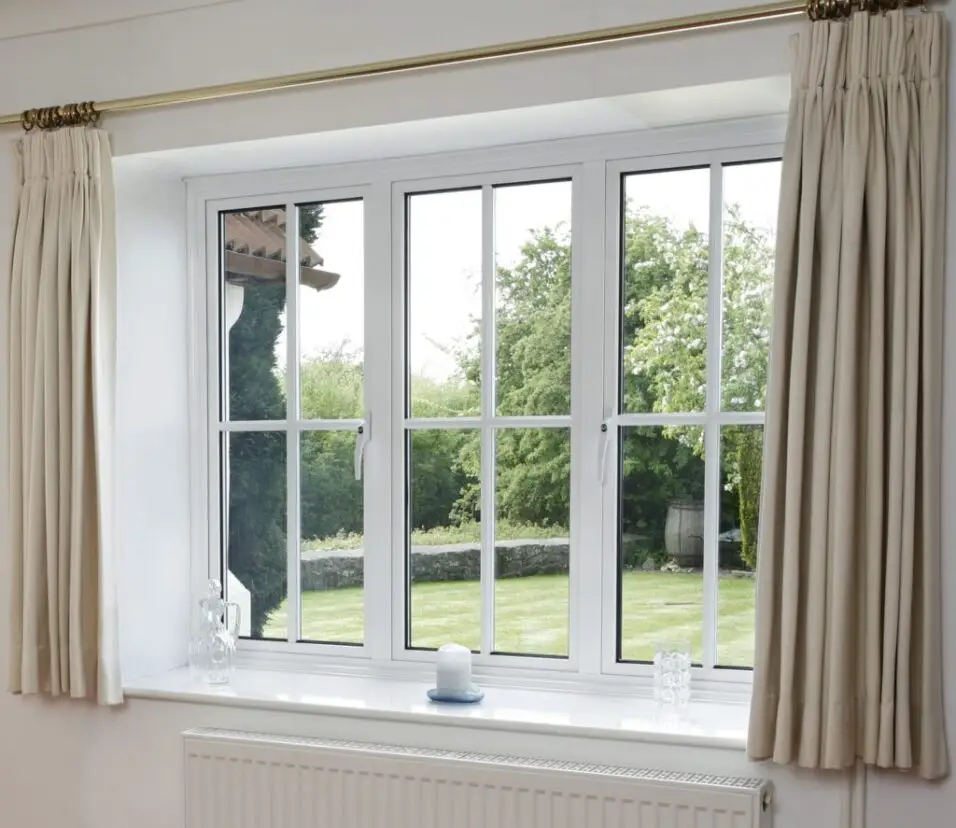How To Seal Exterior Windows
Introduction
How To Seal Exterior Windows: Ensuring the integrity of your home’s exterior windows is crucial for energy efficiency, comfort, and overall maintenance. Exterior windows not only allow natural light to brighten your living spaces but also play a vital role in protecting your home from the elements. Over time, weathering and wear can cause leaks and drafts, leading to increased energy bills and a less comfortable living environment.
In this comprehensive guide on how to seal exterior windows, we will take you through the step-by-step process of identifying, repairing, and maintaining the seals around your windows. Whether you’re a seasoned DIY enthusiast or a novice looking to save on utility costs, our guide will equip you with the knowledge and skills needed to seal your windows effectively. From assessing the condition of your window seals to selecting the right materials and tools, we’ll cover it all.
By following our expert advice, you can not only enhance the energy efficiency of your home but also extend the lifespan of your windows, ultimately saving you money and increasing your home’s overall comfort and value.

Which sealant is best for exterior windows?
Silicone caulks
Silicone caulks are among the best caulks for sealing windows. Helps provide a long-lasting seal that can be applied against interior or exterior windows and its flexible material will not crumble in hot or cold temperatures.
The choice of sealant for exterior windows depends on various factors, including the window material, climate, and personal preferences. However, the two most common types of sealants used for exterior windows are silicone and acrylic latex.
- Silicone Sealant: Silicone sealant is an excellent choice for exterior windows due to its durability and flexibility. It creates a strong, waterproof barrier that can withstand exposure to harsh weather conditions, UV rays, and temperature fluctuations. Silicone adheres well to glass, metal, and many other materials commonly used in window frames. It remains flexible over time, accommodating the natural expansion and contraction of materials, making it less likely to crack or break. This flexibility ensures a long-lasting seal.
- Acrylic Latex Sealant: Acrylic latex sealant is another popular option. It is easy to work with, dries relatively quickly, and can be painted over to match your window frame’s color. While it may not be as durable as silicone in extreme conditions, it still provides good protection against drafts and moisture. It’s often a more budget-friendly option compared to silicone.
Ultimately, the best sealant for your exterior windows depends on your specific needs and the conditions your windows are exposed to. It’s essential to select a high-quality sealant, ensure proper surface preparation, and follow the manufacturer’s instructions for the best results.
Is window sealant waterproof?
Glazing and frame sealants come in a variety of acrylic and silicone based sealants, used to keep your home free from water ingress. Frame sealant is flexible and designed to withstand UV, weather and water exposure. Many can be painted over to match the colour of your windows or frames.
Yes, window sealants are designed to be waterproof. The primary purpose of a window sealant is to create a watertight barrier between the window frame and the surrounding structure, preventing water infiltration. This is crucial to protect your home from water damage, mold growth, and drafts.
Window sealants, such as silicone and some high-quality acrylic latex sealants, are especially effective at repelling water. When applied correctly, they form a waterproof seal that prevents moisture from seeping into the gaps around your windows. This waterproofing ability is essential because windows are vulnerable points in your home’s envelope, and water infiltration can lead to significant issues over time.
The effectiveness of the waterproof seal depends on the quality of the sealant, proper surface preparation, and correct application techniques. It’s crucial to follow the manufacturer’s instructions and ensure that the sealant fully covers any potential entry points for water. Additionally, regular inspection and maintenance of your window sealant can help prolong its waterproofing capabilities and protect your home from water-related problems.
What happens if you don’t seal windows?
You’ll lose money on energy bills.
20% of heat in the home is lost through windows and doors. Once your window seal has failed, cold air from outside is free to enter the home. This increases the amount you’ll be spending on energy bills – even unknowingly.
If you neglect to seal your windows properly or if your window seals deteriorate over time, several negative consequences can occur:
- Energy Loss: Unsealed windows can allow drafts of cold air in during winter and hot air in during summer, causing your HVAC system to work harder to maintain a comfortable temperature. This results in higher energy bills.
- Moisture Infiltration: Without proper sealing, rainwater can seep into your home, leading to water damage, mold growth, and potential structural issues over time.
- Drafts and Discomfort: Inadequately sealed windows can create drafts, making your home less comfortable and causing temperature fluctuations in different areas.
- Noise Pollution: Poorly sealed windows allow noise from outside to enter your home, reducing your overall comfort and privacy.
- Reduced Indoor Air Quality: Airborne pollutants can enter your home through gaps around windows, affecting the quality of the air you breathe.
In summary, neglecting to seal your windows can lead to increased energy costs, potential structural damage, reduced comfort, and health concerns. Regularly inspecting and maintaining your window seals is crucial to avoid these problems and ensure the long-term efficiency and integrity of your home.
Can I seal my own windows?
Apply weatherstripping snugly against both the sash and frame. Be careful not to interfere with the operation of the window. If you choose caulk to seal your windows, first clean them and make sure they are dry. You can apply caulk to all joints in a window frame and the joint between the frame and your wall.
Yes, you can seal your own windows, and it’s a doable DIY project for many homeowners. Sealing windows is a practical way to improve energy efficiency, reduce drafts, and enhance the comfort of your home. The process typically involves cleaning the window frames, removing old sealant or caulk, applying new sealant or weatherstripping, and sometimes adding window film or insulation.
Here are the basic steps to seal windows:
- Assessment: Inspect your windows to identify gaps, cracks, or areas where air is leaking. This will help you determine where sealing is needed.
- Clean: Thoroughly clean the window frames and the surrounding areas. This ensures that the sealant adheres properly.
- Remove Old Sealant: If there’s old, deteriorating sealant or caulk, remove it using a scraper or a utility knife.
- Apply New Sealant: Depending on the type of window and the gaps you’re sealing, choose an appropriate sealant, such as silicone or acrylic latex. Apply the sealant in a continuous bead along the gaps, and use a caulking gun for precision.
- Smooth and Shape: Use a caulking tool or your finger dipped in soapy water to smooth and shape the sealant for a neat finish.
- Add Weatherstripping: If needed, you can also install weatherstripping around the window frame or sash to create an airtight seal.
While sealing your own windows is feasible for many, it’s essential to follow proper techniques and use high-quality materials. Incorrectly applied sealant can be less effective and less durable. If you’re unsure about your DIY skills, consider seeking guidance from home improvement resources or consulting with a professional.
How long does window sealant last?
For long-lasting protection around your windows, choose a high quality caulk made from silicone or polyurethane. 100% silicone caulk or a mix of silicone and latex, is waterproof, flexible, shrink-proof and will last over 20 years.
The lifespan of window sealant varies depending on the type of sealant used, environmental factors, and the quality of application. Generally, you can expect different sealants to last the following durations:
- Silicone Sealant: Silicone sealant is known for its durability. When applied correctly, it can last anywhere from 20 to 25 years or more. Silicone maintains its flexibility over time, which helps it withstand temperature fluctuations and maintain its effectiveness.
- Acrylic Latex Sealant: Acrylic latex sealant is less durable than silicone but still provides good performance. It typically lasts around 10 to 15 years. However, it may require more frequent touch-ups or resealing in areas with extreme weather conditions.
- Butyl Rubber Sealant: Butyl rubber sealants are often used for automotive applications but can also be used for windows. They have a lifespan of approximately 15 to 20 years.
It’s important to note that exposure to UV rays, temperature fluctuations, and moisture can all affect the longevity of window sealants. Regular maintenance, such as inspecting and resealing as needed, can help extend the lifespan of your window sealant.
What is the cheapest way to seal windows?
Insulate Windows by Installing Plastic Film Around the Glass
We love this tip because it’s so cheap! Plastic film, whether self-adhesive or shrink-wrapped to the window with a hairdryer, is a a low-cost way to protect against cold coming through the glass.
If you’re looking for a cost-effective way to seal windows, there are several budget-friendly options:
- Weatherstripping: Weatherstripping is an inexpensive way to seal gaps around windows. It typically comes in rolls or strips made of materials like foam, rubber, or felt. You can easily install it around the window frame or sash to create an airtight seal.
- Caulk or Sealant: A tube of caulk or sealant is relatively affordable, and it can be used to seal small gaps and cracks around windows.
- Window Film: Window film, often used for insulating windows, is cost-effective and can significantly reduce heat loss in the winter.
- Draft Stoppers: Draft stoppers, also known as draft snakes or door sweeps, can be used at the base of windows to block drafts. These are low-cost solutions that can be effective in reducing energy loss.
- Plastic Window Insulation Kits: These kits consist of clear plastic film that you apply to the interior of your windows. They create a layer of insulation that reduces heat transfer. Plastic window insulation kits are affordable and easy to install.
Remember that while these solutions are cost-effective, their effectiveness may vary depending on the severity of your window issues and the quality of installation. For long-term solutions and more substantial energy savings, investing in higher-quality materials or professional installation may be necessary.
Should I seal windows with plastic?
Not every home benefits from plastic window wrap. For instance, if you have brand-new windows and doors with minimal gaps, plastic wrap may not make a noticeable difference. However, if your windows have serious air leaks, plastic window wrap can help.
Sealing windows with plastic, often done using plastic window insulation kits, can be a cost-effective and temporary solution to improve insulation and energy efficiency, especially during cold winter months. However, whether you should seal your windows with plastic depends on your specific needs and circumstances. Here are some factors to consider:
Pros of Sealing Windows with Plastic:
- Energy Savings: Sealing windows with plastic can significantly reduce heat loss during the winter. It creates an additional layer of insulation that traps air, preventing cold drafts and reducing the workload on your heating system. This can lead to lower energy bills.
- Affordability: Plastic window insulation kits are generally inexpensive and readily available at hardware stores. This makes them an attractive option if you’re on a budget.
- Ease of Installation: Installing plastic window film is a relatively simple DIY project that requires minimal tools. Most kits come with clear plastic film and double-sided tape, making it accessible for homeowners without extensive DIY experience.
- Reversibility: Plastic window sealing is a temporary solution that can be easily removed when the winter season is over or when you no longer need it. This is especially beneficial for renters or for those who prefer not to make permanent modifications to their windows.
Cons and Considerations:
- Aesthetics: Some people find that plastic film on windows affects the visual appeal of their home, as it can slightly obscure the view and create a shiny or wrinkled appearance.
- Temporary Solution: Plastic window sealing is not a permanent fix, and it needs to be reapplied each winter season. It may not provide year-round benefits.
- Visibility: Depending on the quality of the film and installation, it may slightly reduce visibility through the window.
- Moisture Issues: If not installed correctly, condensation can form between the plastic and the window, potentially leading to mold or mildew if not addressed.
- Not Suitable for All Windows: Plastic sealing works best on standard, single-pane windows.
In summary, sealing windows with plastic can be an effective and budget-friendly way to improve insulation and energy efficiency temporarily, especially for single-pane windows. It can result in energy savings and increased comfort during the colder months. However, it’s essential to consider the aesthetics, temporary nature, and potential moisture issues associated with this method. For a more permanent solution or for windows with more complex insulation needs, you may want to explore other options such as weatherstripping, adding window treatments, or upgrading to energy-efficient windows.
What is a window sealer?
A window seal refers to the sealant around the window used to hold in air or gas between the panes of glass. When this breaks, moisture and humidity can build up between the glass in your window, creating a fog inside the windows and decreasing your home’s energy efficiency.
A “window sealer” is not a standard term in the field of windows and home improvement. However, it might refer to one of two possible things:
- Window Sealant: In most cases, when people mention a “window sealer,” they are likely referring to a window sealant. Window sealant, often known as caulk, seals gaps and seams around windows to prevent air and water entry. These sealants help improve energy efficiency, prevent drafts, and protect against moisture infiltration.
- Window Weatherstripping: Alternatively, “window sealer” might refer to weatherstripping materials used to seal gaps around windows. While it’s not a traditional sealant, weatherstripping serves a similar purpose in preventing drafts and improving insulation around windows.
In both cases, the goal is to improve the energy efficiency and comfort of your home by sealing gaps and preventing air and water from entering or escaping around your windows. The specific choice of sealant or weatherstripping material depends on factors like the type of window, the location, and the desired level of sealing.

Conclusion
Properly sealing your exterior windows is a valuable investment in your home’s well-being. By following the steps outlined in this guide, you can take control of your home’s energy efficiency, comfort, and longevity. Repairing and maintaining your window seals isn’t just a one-time task; it’s an ongoing process that pays off in reduced energy bills, increased indoor comfort, and the protection of your home against the elements.
Remember that seal window maintenance is a cost-effective way to prevent potential issues down the road. So, take the time to assess and address any seal-related problems promptly. By doing so, you’ll ensure that your home remains a cozy and efficient sanctuary for years to come.
Thank you for joining us on this journey to seal your exterior windows effectively, and we wish you success in making your home more comfortable and energy-efficient.







